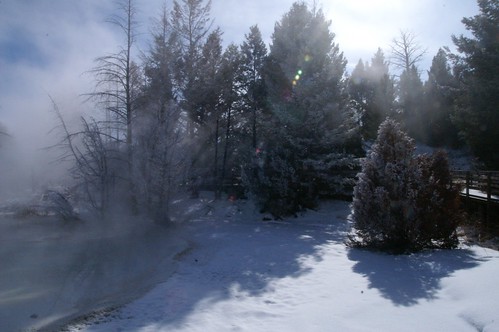So I finally got around to taking that trip to Yellowstone that I was talking about back in May. Rather than going in late August 2009, as I had planned, I actually ended up going last month (that’d be March, 2010). For those of you not familiar with weather in the Northern Hemisphere, that meant going in what amounts to the dead of winter, instead of the height of summer — and as far as I’m concerned, it was the best thing that could have happened to the trip.
While we didn’t have the Park to ourselves, exactly, we were much closer to it than we would have been in August. And wildlife was much easier to spot as well. Although I didn’t snag a shot of one of Yellowstone’s coveted wolves, I did get some nice images of the local bison, coyotes, birds, etc. All in all, a great trip, and I highly recommend a winter excursion to the park for anyone who hasn’t done it already. You won’t be disappointed.
But that’s not my purpose here. In my earlier post I made soem guesses about what I thought my photography habit was going to set me back, in terms of consumables (in the form of storage), for the trip. In that post I had guessed that I’d fill two 4GB cards, which I thought would be fine for my relatively low-resolution (by 2010 standards) DSLR.
As it turned out, I was a little low.
Over the course of nine days, I took a total of 2,299 frames, equivalent to about 64 rolls of 135, and consuming just under 20GB. Just sorting through then and making a ‘first cut’ is a project in itself.
Part of the reason I ended up taking so many frames (and I’m using the word “frames” rather than “images” carefully here) is because I had brought my laptop along with me on the trip and as a result knew I didn’t have any reason to conserve storage space. The limiting factor on my shooting wasn’t storage, but instead camera batteries. With a 4GB and 8GB card, I could easily shoot all day and then dump the contents to my laptop at night for storage and immediate backup to a DVD.
This led to an immediate change in my shooting style that I never would have made, if I’d been shooting film or even using the digital without the hundreds of gigabytes of disk storage that the laptop represented: I turned on three-frame, +/-0.5 EV bracket mode on the first day and never turned it off. That’s something I’ve never felt rich enough to do on my film Maxxum.
So those 2299 frames really represent something like 800 images (I did take a few without bracket mode, so that’s a low estimate), much closer to my initial estimate of 20 or so 35mm rolls worth. It’s just that, rather than only having one frame for each image, with the digital I have two “insurance” frames, in case my judgement of the light was a bit off or I just decide that slightly lighter or darker is preferable. Although not earth-shattering by any means, I do think the bracketing saved a few marginal images that otherwise would have been garbage if I’d only had the “center” one. And that’s enough to make me a pretty happy photographer.
0 Comments, 0 Trackbacks
